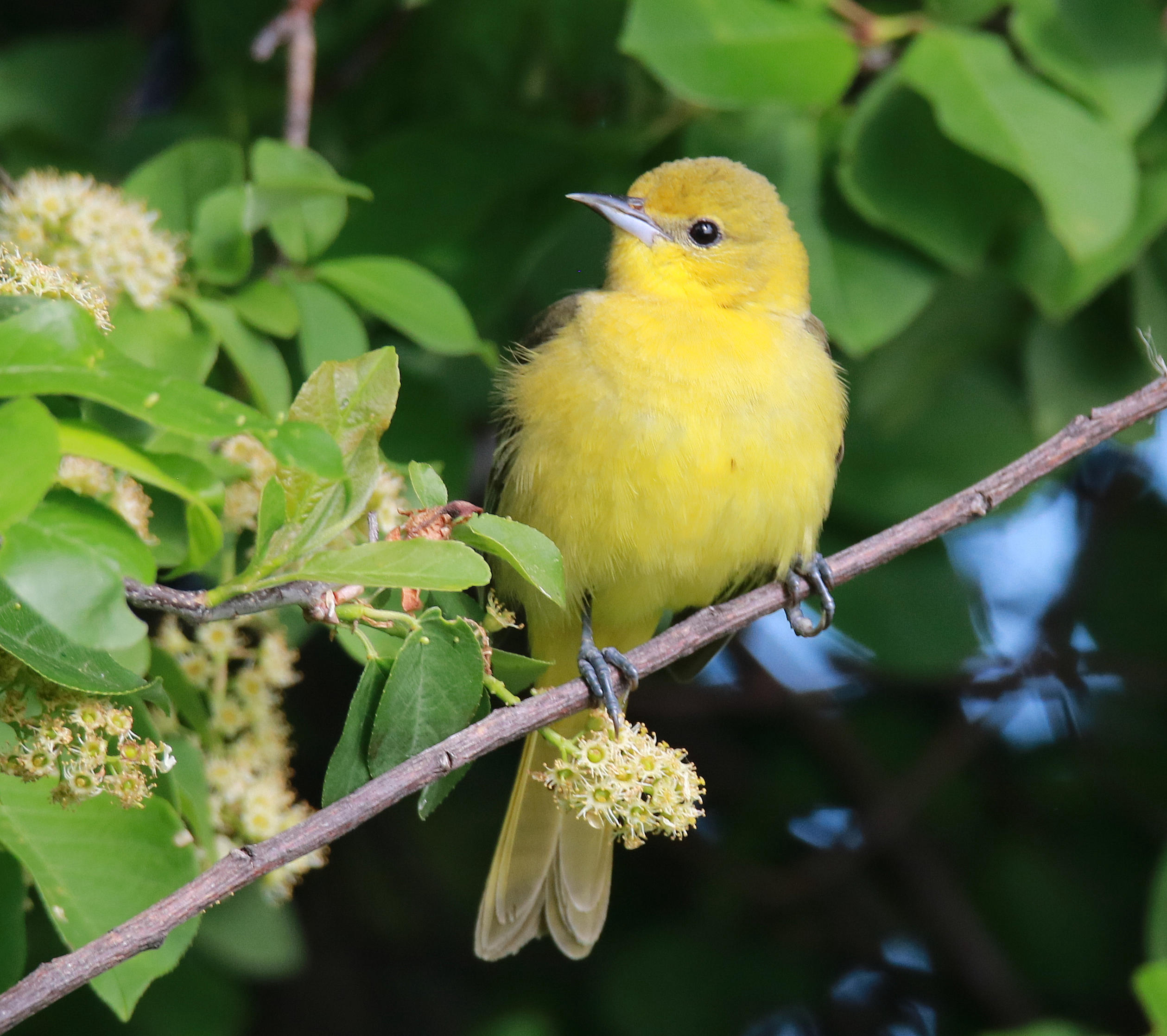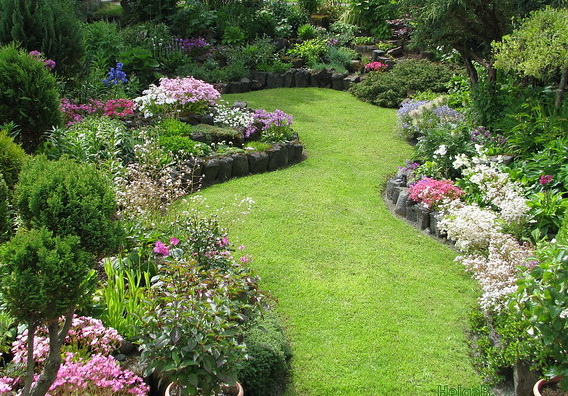
A variety of birds will be attracted to a landscaped yard with different kinds of plants growing at different levels. This female Orchard Oriole foraged for insects and caterpillars in a a backyard where wild plum trees were planted (photo by Paul Konrad).

Open lawns are highly over-rated when compared with a fully landscaped yard, although most of our yards are a compromise between the two. Many birders are transitioning areas of their lawn with new landscaping additions, during spring, as the growing season progresses, and from year to year – a little section at a time. Create a few curves in your landscaping to add a flowing shape that evokes an artistic flare.
|
When we are landscaping, and planning for landscaping, it’s always important to look at the big picture – the entire yard – but that can be overwhelming too. Sometimes it’s best to look at a small part of your yard, then another part of your yard, making improvements one area at a time. Most of us have some established landscaping features, with some important benefits and attractions for birds – trees and bushes that provide macro-habitat, with colorful flower gardens, and seed-producing gardens that include sunflowers, grains, grass seeds, and more; but all to help beautify your yard at the same time.
Landscaping can be done in easy-to-plan, easy-to-complete increments; then, when one task is done and you see how good it looks, and how it adds to your yard’s overall look, even in a small way, you can move on to the next small project – some quicker and easier to complete, others more involved perhaps. But each project has a common theme: To benefit birds while improving the look of your yard, which will make you more satisfied and happier.
Early spring is when we all like to get our hands a little dirty, dig in the soil, add some mulch or organics, plant some new flowering plants, and maybe a couple shrubs or a tree. Heck, last year we planted a few grape vines and raspberry bushes, and they were such a hit, adding new leaf shapes and fall colors to areas of our yard. They also attracting birds that fed on the fruits, so we are going to expand those plantings this year, adding more grapes and more raspberries to last year’s plantings, and maybe also adding another plot for each of those berry selections. We also want to plant a border of strawberries around each of the grape and raspberry patches to add another level of greenery and places for ground-oriented birds to forage.
A few strategically positioned berry-producing shrubs can also add a lot to the look of a corner of your yard, as well as add another elevation of foliage and color. Some shrubs have reddish or gold-colored leaves, and even if it’s not on the top of your mind during spring, ask about shrubs that create attractive fall colors too. Shrubs provide great backyard habitat for birds, as cover, potential food sources, and even for nesting. That’s especially considering shrubs can vary from a few feet high to 6 feet tall and taller.
A single tree can make a huge difference in a bird-friendly yard. In the spring a flowering tree attracts birds that feed on nectar, and many migrating songbirds feed on small insects attracted to flowering trees. During late summer fruits will provide food sources for a variety of birds, and fruits can last into fall and winter if they are not utilized earlier. Any tree can provide cover, shade, roosting sites, and a place to build a nest, but it’s nice when a tree has multiple purposes, and can provide a food source too – although insects and caterpillars that inhabit the leaves and bark of trees are excellent food sources too. You may be interested in a mix of deciduous trees with some conifers, and keep in mind that not every tree needs to grow to its tallest, you can easily keep some trees trimmed to smaller dimensions, and young trees add a lot to the vegetative levels of a yard. Always keep native shrubs and trees in mind too, as natives grow best, and birds have evolved with those plants over time.
Flower gardens may be the most popular way to add color to our yards, and even when the plants are not in flower, the vegetation that flowering plants create adds areas for birds to search for insects. Of course, most flowers will produce nectar for hummingbirds, but the key to providing a hummingbird garden, or a number of hummingbird gardens, is to understand that hummingbirds are most attracted to red tubular flowers. And there is a reason why that’s true: Red flowers produce nectar with the highest sugar content; hummingbirds instinctively know that and are drawn to red flowers first. That’s also why hummingbird feeders tend to have some red coloration – to attract hummingbirds.
That doesn’t mean you should limit your flower selections to red flowering plants though. Mix in some yellow and orange flowers too, but watch and see which flowers get the most hummingbird action. Tubular flowers are made to produce and hold nectar, so that’s an even more important consideration when selecting plants for flower gardens. Just like with trees and shrubs, it’s a good plan to create different levels of plants in your flower gardens with taller plants in the rear or the center, and other levels of plants leading down to ground cover.
The other thing to keep in mind when planning and selecting flowering plants is the fact that there are 2 primary types of flowering plants – annuals and perennials. Both types are valuable additions to any yard, but while annuals live for less than one year and therefore need to be planted as seeds or transplanted from greenhouse stock each year, perennials live for longer than 2 years with a dormant period each year. Of course, flowering plants come in many different sizes and shapes, with varied leaves, and they even include many vines, most notably trumpet vines, which are definitely hummingbird magnets.
We always like to remind birders that one of the simplest ways to add interest and an attractive touch to your yard is to use oval-shaped or circular plantings and flower garden areas rather than the all too common rectangles and squares. Same with lines of bordering plants – give them a few curves to add shape to your landscaping elements that shows an artistic flare to your landscaping.
That’s the case with decorative grasses too; you can buy a number of different kinds of tall decorative grasses to add variety to your yard. Perhaps the easiest way to add a little dimension to your yard is to create some unmowed areas of your lawn that are permitted to grow to full size and seed. Create an oval of unmowed grass in a strategic location, simply by mowing around an oval-shaped area – and see how much you come to appreciate how that decorative grass breaks up the monotony of an expanse of mowed lawn. You will undoubtedly enjoy seeing the grass blow in the wind, and watch the seed heads grow and mature. During fall, the taller grass will dry into a yellow color that is every bit as decorative as the summer greens, and if you live in an area where it snows, you will appreciate the stand of grass surrounded by winter white.
We have also come to prefer leaving a perimeter of unmowed lawn around each of our trees. Get rid of that “weed-whacker” and be a little less clean-edged as you mow and trim plants. We find it provides a little more natural look to our yard, and as we improve and expand the birdscaping in our yard, we appreciate the results more and more – as do the birds we hope.
One more thing: Just as we strive to keep our feeding station, including our birdbath, clean, healthy, and attractive, we can make it even more attractive during the growing season when we can add flowering plants or shrubs to surround or anchor the feeding station. And that can be in the form of potted plants. A variety of sizes and shapes of pots can add color and style, and you can add to a color theme you may have going among your feeders too. Another plus about potted plants is that you can move them anytime, changing the look of one side of the feeding station or another.
At the same time, you can incorporate a variety of potted plants with red or yellow tubular flowers anywhere in your yard, including a patio, deck, or balcony. Grow some sunflowers in a big pot to attract goldfinches too. In essence, there are a variety of ways we can all make a few improvements to our yards to make our home more attractive to us, our families, neighbors, visitors – and to birds as we provide more and more urban habitat for birds each year. Are you ready to get started? Or have you already started this year’s version of birdscaping as your yard matures and beautifies your view beyond your front and back doors. Enjoy this spring season!
Share your backyard birding experiences and photographs with The Birding Wire at editorstbw2@gmail.com